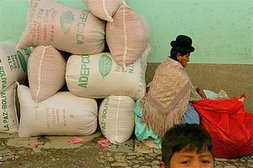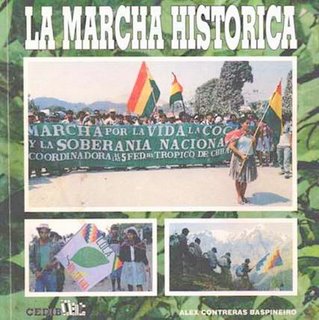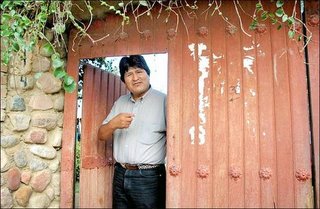Bridge Blog Index
From Global Voices
| Table of contentsshowTocToggle("show","hide")[hide] |
What are BridgeBlogs?
Hossein Derakhshan (aka. Hoder) proposed three models for ways people can use weblogs to communicate between cultures: windows, bridges and cafés. Windows allow us to look into another culture, but not interact - an example might be a weblog of someone in another country, talking about her daily life to her friends and family. We've got a chance to look in, but we're not invited to interact.
Cafés are complex spaces where groups of people can meet to discuss in ways that they can't meet in the real world, due to geography, politics or language. Joi Ito's IRC channel (http://joiwiki.ito.com/joiwiki/index.cgi?ircchannel) is a good example of a café.
Bridges are more interactive than windows, but less complex than cafés. They're usually the project of a single blogger, or a small group of authors. Bridge bloggers write for an audience outside their everyday reality - for instance, when Ory Okolloh (http://blogs.law.harvard.edu/ory) writes about corruption in Kenya, reaching family at home and readers at Harvard, she is bridge blogging. (And when people comment on her blog from outside Kenya, they're bridging back.
Some other great examples of bridge blogs:
Editor, Myself (http://www.hoder.com/weblog/) - Hossein Derakshan's English-language blog
Where is Raed? (http://dear_raed.blogspot.com/) - Salam Pax's blog from Baghdad, now on indefinite hiatus. One of the original and most widely known bridgeblogs.
Black Looks (http://okrasoup.typepad.com) - Sokari Ekine's blog on African Women's issues
Screenshots (http://www.jeffooi.com/) - Jeff's Ooi's blog on Malaysian politics
We're interested in creating an index of these types of online spaces, with a special emphasis on bridge spaces. This index, as it grows will be a resource for people who want to understand what's going on in different parts of the world from a personal perspective, as well as a journalistic or encyclopedic perspective. We hope this will be a resource for the mainstream media as they look for local voices to expand coverage in parts of the world they routinely fail to cover, as well as for individuals.
- including IRC chans, Usenet lists, Yahoo groups, etc?
yes, if they meet other aspects of the definition. It's easiest for us to track blogs and wikis because of RSS, but we're very open to the notion that lots of this content is posted in other kinds of spaces... EthanZ 16:20, 6 Jun 2005 (EDT)
How do we maintain this index?
Well, that's a work in progress.
Here's a methodology that EthanZ, Sj, RMack (http://rconversation.blogs.com/) and Joho (http://www.hyperorg.com/blogger) converged on in a recent discussion at Berkman (http://cyber.law.harvard.edu/home/) to start indexing individual bits of bridge-content:
Individuals agree to watch a country or an issue. This includes watching Technorati (http://www.technorati.com), Flickr (http://www.flickr.com) and del.icio.us tags, as well as any prominent weblogs already identified as being from/about that country.
When a watcher finds a photo, post or article focused on that country, s/he uses del.icio.us to tag it, using the country name as a tag - i.e., if Ethan finds a blogpost about a new tech company in Accra, he tags it "ghana". If he finds a blog that consistently writes about Ghana, he tags it "gv-ghana", a special tag which means that a Global Voices watcher has identified a likely bridgeblogger.
Watchers maintain wiki pages within the Global Voices wiki which list identified bridgebloggers and the sources being watched. These pages invite other people to join in watching a country, or take on watching another country or issue.
As many watchers start using the gv-noun tags, it may become neccesary to aggregate a subset of trusted watchers - that's a script we can write if the need arises.
Global Index
We are trying to create a global index of bridge content. For examples of what people are trying to do with these index pages, see Ghana, Antarctica or Morocco.
Feel like watching a nation? Please add your name next to the country in the list below, and add the page itself to your watchlist (follow the "Watch this page" link once you're looking at the page itself). Then watch the feeds listed on the page for new bridge sources, and add them to the page when you find them... or add your own favorite feeds to the list.
Template: If you need assistance on how to add information to each page, please take a look at Nepal page. You can use the structure of that page as a template.
(Countries are from Wikipedia's List of Countries by Continent (http://en.wikipedia.org/wiki/List_of_countries_by_continent) - decisions on what is a country and what continent it belongs to (controversial topics) are made by the Wikipedia authors.
#Africa | #Antarctica | #Asia | #Europe | #North and Central America | #Oceania | #South America
Africa
- African Continent
- Algeria
- Angola
- Benin
- Botswana
- Burkina Faso
- Burundi
- Cameroon
- Cape Verde
- Central African Republic (Centrafrique)
- Chad (Tchad)
- Comoros
- Republic of the Congo
- Democratic Republic of the Congo
- Côte d'Ivoire (Ivory Coast)
- Djibouti
- Egypt (Misr)
- Equatorial Guinea
- Eritrea
- Ethiopia (Itiopia)
- Gabon
- The Gambia
- Ghana
- Guinea
- Guinea-Bissau
- Kenya
- Lesotho
- Liberia
- Libya
- Madagascar
- Malawi
- Mali
- Mauritania
- Mauritius
- Mayotte (France)
- Morocco (Al Maghrib)
- Mozambique
- Namibia
- Niger
- Nigeria
- Réunion (France)
- Rwanda
- Saint Helena (United Kingdom)
- São Tomé and Príncipe
- Senegal
- Seychelles
- Sierra Leone
- Somalia
- South Africa
- Sudan
- Swaziland
- Tanzania
- Togo
- Tunisia
- Uganda
- Western Sahara (claimed by Morocco)
- Zambia
- Zimbabwe
Antarctica
Asia
- Afghanistan (افغانستان)
- Armenia
- Azerbaijan
- Bangladesh
- Bhutan
- British Indian Ocean Territory
- Brunei
- Cambodia (Kampuchea)
- China, People's Republic of (中国)
- Christmas Island (Australia)
- Cocos (Keeling) Islands (Australia)
- East Timor (Timor Leste)
- Georgia (Sakartvelo)
- Hong Kong (China) (中国香港)
- India (Hindi: Bharat)
- Indonesia
- Japan (Nihon)
- Kazakhstan
- Korea
- Kyrgyzstan
- Laos
- Macau (China) (中国澳门)
- Malaysia
- Maldives
- Mongolia
- Myanmar (Burma)
- Nepal
- North Korea
- Pakistan
- Philippines (Filipinas)
- Singapore
- South Korea
- Sri Lanka
- Taiwan
- Tajikistan
- Thailand (Muang Thai)
- Turkey - Ankara
- Turkmenistan
- Uzbekistan
- Vietnam
Middle East
- Bahrain (بحرین)
- Iran (ایران)
- Iraq (عراق)
- Israel (Yisra'el)
- Jordan (Al Urdun)
- Kuwait (کویت)
- Lebanon (Lubnan)
- Oman (عمان)
- Palestine
- Qatar (قطر)
- Saudi Arabia
- Syria
- United Arab Emirates
- Yemen (یمن)
Europe
- Albania (Shqipëria)
- Andorra
- Austria (Österreich)
- Belarus
- Belgium
- Bosnia Herzegovina
- Bulgaria (България)
- Croatia (Hrvatska)
- Cyprus (Kupros)
- Czech Republic (Česko)
- Denmark (Danmark)
- Estonia (Eesti)
- Faroe Islands (Denmark)
- Finland (Suomi)
- France
- Germany (Deutschland)
- Gibraltar (United Kingdom)
- Greece (Hellas)
- Hungary (Magyarország)
- Iceland (Ísland)
- Republic of Ireland (Eire)
- Italy (Italia)
- Latvia (Latvijas)
- Liechtenstein
- Lithuania (Lietuva)
- Luxembourg
- Republic of Macedonia (Македонија)
- Malta
- Moldova
- Monaco
- the Netherlands (Nederland)
- Norway (Norge)
- Poland (Polska)
- Portugal
- Romania (România)
- Russia (Россия)
- San Marino
- Serbia and Montenegro (Србија и Црна Гора)
- Slovakia (Slovenská)
- Slovenia (Slovenija)
- Spain (España)
- Svalbard and Jan Mayen (Norway)
- Sweden (Sverige)
- Switzerland
- Ukraine (Україна)
- United Kingdom
- Vatican City
North and Central America
- Anguilla
- Antigua and Barbuda
- Aruba
- Bahamas
- Barbados
- Belize
- Bermuda
- British Virgin Islands (United Kingdom)
- Canada
- Cayman Islands
- Costa Rica
- Cuba
- Dominica
- Dominican Republic (Republica Dominicana)
- El Salvador
- Greenland (Denmark)
- Grenada
- Guadeloupe (France)
- Guatemala
- Haiti
- Honduras
- Jamaica
- Martinique (France)
- Montserrat (United Kingdom)
- Mexico (México)
- Nicaragua
- Panama (Panamá)
- Puerto Rico (United States)
- Saint Kitts and Nevis
- Saint Lucia
- Saint-Pierre and Miquelon (France)
- Saint Vincent and the Grenadines
- Trinidad and Tobago
- Turks and Caicos Islands (United Kingdom)
- United States
- U.S. Virgin Islands (United States)
Oceania
- American Samoa
- Australia
- Cook Islands
- Fiji
- French Polynesia
- Guam
- Kiribati
- Marshall Islands
- Federated States of Micronesia
- Nauru
- New Caledonia (France)
- New Zealand
- Niue
- Norfolk Island (Australia)
- Northern Mariana Islands (United States)
- Palau
- Papua New Guinea
- Pitcairn Islands
- Samoa
- Solomon Islands
- Tokelau
- Tonga
- Tuvalu
- Vanuatu
- Wallis and Futuna Islands
South America
- Argentina
- Bolivia
- Brazil (Brasil)
- Chile
- Colombia
- Ecuador
- Falkland Islands (United Kingdom)
- French Guiana (France)
- Guyana
- Netherlands Antilles (The Netherlands)
- Paraguay
- Peru
- South Georgia and the South Sandwich Islands (United Kingdom)
- Suriname
- Uruguay
- Venezuela
Similar projects/web sites
Globe of Blogs (http://www.globeofblogs.com/)
GeoURL2.0 (http://geourl.org/)
blogmap by cities (http://www.cathome01.com/blogmap/) Best Blogs in Asia Directory (http://www.misohoni.com/bba/)









